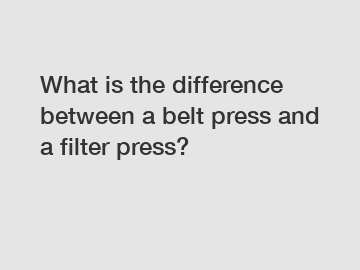What is the difference between a belt press and a filter press?
If you want to learn more, please visit our website Huaqiang.
When it comes to dewatering processes in industries such as wastewater treatment, mining, and food processing, two common options are belt presses and filter presses. Both of these devices are used to separate solids from liquids, but they employ different methods and have distinct advantages and disadvantages.
Let's start by looking at the belt press. A belt press, also known as a belt filter press, is a machine that utilizes a series of rollers to squeeze and compress a slurry of solid material and liquid between two belts. The slurry is fed into the machine, and as the belts move, the liquid is forced out through the pores in the belts, leaving behind a cake of solid material. The belts are then washed to remove any remaining liquid, and the resulting cake can be disposed of or further processed.

One of the key advantages of a belt press is its continuous operation. Because the slurry is fed into the machine constantly and the belts move continuously, a belt press can handle a high volume of material and produce a constant stream of dewatered solids. This makes it especially useful in applications where a consistent output is needed.
On the other hand, a filter press operates on a batch cycle. A filter press consists of a series of plates with filter cloths between them. The slurry is pumped into the chamber formed by the plates and cloths, and pressure is applied to force the liquid out through the cloths, leaving behind a cake of solid material. Once the chamber is full, the process is stopped, and the cake is removed.
One of the main advantages of a filter press is its ability to produce a higher solids content in the dewatered cake than a belt press. This is due to the higher pressure that can be applied in a filter press, which helps to squeeze out more liquid from the slurry. This can be important in applications where the dewatered solids need to be disposed of or further processed.
Another key difference between a belt press and a filter press is their footprint. A belt press typically has a larger footprint than a filter press, as it requires more space to accommodate the belts and rollers. This can be a consideration in situations where space is limited or where a smaller machine is desired.
In terms of maintenance, both belt presses and filter presses require regular cleaning and upkeep to ensure optimal performance. Belts and filter cloths need to be replaced periodically, and the machinery should be inspected and serviced on a regular basis to prevent breakdowns and ensure efficient operation.
When it comes to choosing between a belt press and a filter press for a dewatering application, there are several factors to consider. The volume of material to be processed, the desired solids content in the dewatered cake, the available space, and the required level of automation are all important considerations.
Ultimately, both belt presses and filter presses have their strengths and weaknesses, and the choice between the two will depend on the specific needs of the application. Whether you opt for a continuous belt press or a batch filter press, both devices are valuable tools for dewatering processes and can help industries achieve their desired outcomes efficiently and effectively.
If you want to learn more, please visit our website.
If you want to learn more, please visit our website Polyester Spiral Belt.
122
0
0


Comments
All Comments (0)